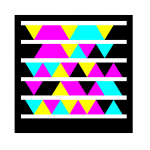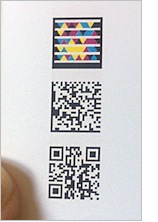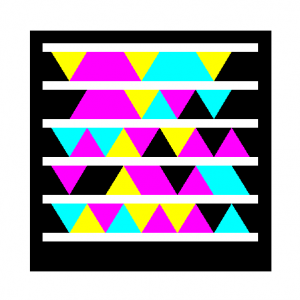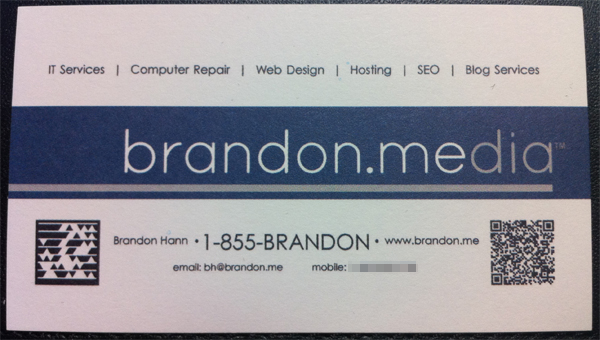Back in April, I wrote an article about using digital barcodes on your business cards, but today, Microsoft just took their service out of beta mode and I decided there was a lot more to be said on the subject, so here’s a new post just for Microsoft Tag.
First of all, if you haven’t seen my other article, go check it out now. Otherwise, here’s a small breakdown of what it was all about. I was talking about new ways to distribute information while still using an old standard: business cards. Generally, when you meet someone and/or acquire a new business contact, 9 times out of 10, they’ll hand you a business card.
Downsides of business cards
- Cumbersome – I know what you’re thinking…how can these little cards be cumbersome? Well, lets say you go to a trade show and score about 100 of these little cards. Do you know what a stack of 100 business cards looks like?!
- Stagnant – Once your card is printed, there’s no turning back. If your number changes, you have to reprint new cards. This may not be so much of an issue because cards are cheap, but what about all those people in the past that have taken your card? If you don’t have their contact info, you’re screwed.
- Dime-a-dozen – This means that everyone has them and generally speaking, you don’t stick out very much. How can you hand a business card to someone and have them remember who you are?
- Information overload – I’ve seen cards that have so much text on them and 5 different phone numbers that I don’t even know where to begin! Also, have you ever had to sit at your computer and input all that information by hand? How about for 100 cards? Yes, you could purchase a business card scanner, but it’s still a time consuming process.
What is a Microsoft Tag?
 Microsoft has introduced a new barcode format that uses a multi-colored series of triangles to represent data. Essentially it works the same way as other data-enabled barcodes that can store all characters (instead of just numbers). You have most likely seen these barcodes on shipping boxes from FedEx or UPS.
Microsoft has introduced a new barcode format that uses a multi-colored series of triangles to represent data. Essentially it works the same way as other data-enabled barcodes that can store all characters (instead of just numbers). You have most likely seen these barcodes on shipping boxes from FedEx or UPS.
Microsoft has set up a site specifically for those wishing to create their own tags at Tag.Microsoft.com. You can create any number of tags using these tag types:
- URL – This tag type will only contain a URL to your website, so when someone scans it on a mobile device such as iPhone, they will automatically be sent to your website. (The tag to the right is a URL tag for this site. Try it!)
- Free Text – This type allows you to simply create a tag that contains random text. You can use this type if you want to encode some kind of message for your visitors to see. An idea could be a special offer that you’re giving away. Allowing your customers to scan it will create interactivity.
- vCard – This will probably be the type you’ll use most as it allows you to save all of your contact information in the vCard format. You can even import already existing vCards!
- Dialer – The one works similar to the URL type, but instead, it just stores your phone number. Any smartphone that can automatically read phone numbers as such will start an automatic call to the number.
Always up-to-date
The most important item to mention is that once you create a new tag type, it’s already been encoded based on a unique registration number. What this means is that as long as you don’t delete the tag, you can always log into your Tag account and update, change or delete information and the tag image never changes!!
In theory, you can create a business card with nothing on it except your Microsoft Tag and your business card will never get outdated. You could even put a line of text on the card that says “Scan here for updated contact info”
How can I scan these?
All you need to do is get the mobile software for your phone! The easiest way to do this is grab your phone and go to this address: gettag.mobi
Of course, not every device is supported, but here’s a current list of supported operating systems and phones at the time of this writing:
- Android
- Blackberry
- iPhone
- J2ME (Beta)
- Java 2 Micro Edition (Beta)
- PalmOS
- Symbian S60
- Symbian S60 1st Edition
- Symbian S60 2nd Edition
- Symbian S60 3rd Edition
- Symbian S60 5th Edition
- Windows Mobile
- Windows Phone
Final thoughts
This is the ultimate convergence of technology and a proven standard! I remember back with people thought the business card would be replaced by mini cdrom business cards, but imagine handing a disc to someone and then expecting them to have access to a computer at all times to be able to read the contents? This new technology doesn’t have to replace the old…it simply adds to it.
Another possible advantage is that in some cases, you’ll find that you don’t even have to give out your card! Just let someone scan it, get your information and give it right back to you. You don’t even have to put these tags on business cards. Put them on flyers, posters, email signatures, websites, message boards, etc. Here’s one I just thought of: use it as your avatar throughout the Internet!
In the end, what really matters is how you’re being remembered. Right now, not a lot of people are using this technology, so you have the opportunity to stand out above the crowd.
UPDATE: November 18th, 2010
I hadn’t been on the Microsoft site since creating my first tag, but when I decided to finally get my new business cards printed, I went back and discovered some great news. Microsoft now allows you to create tags in black and white! This was such a relief for me because I really didn’t like the fact that they were in color before. I mean no matter what your business cards look like, how will pastel colors ever fit in?!
Anyway, I created my first business cards that can be seen over on my article about putting barcodes on business cards and I think they really turned out well! Both the Microsoft tag and the QR barcode are fully readable by mobile scanners and work just as intended.


